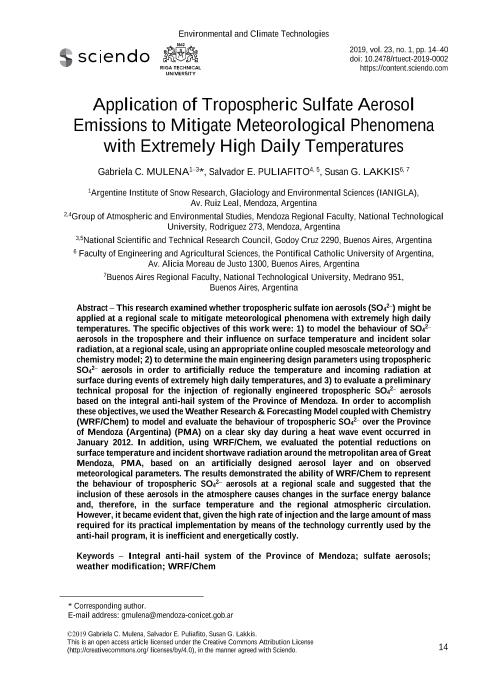Artículo
Application of Tropospheric Sulfate Aerosol Emissions to Mitigate Meteorological Phenomena with Extremely High Daily Temperatures
Fecha de publicación:
03/2019
Editorial:
Sciendo
Revista:
Environmental and Climate Technologies
ISSN:
2255-8837
e-ISSN:
1691-5208
Idioma:
Inglés
Tipo de recurso:
Artículo publicado
Clasificación temática:
Resumen
This research examined whether tropospheric sulfate ion aerosols (SO42-) might be applied at a regional scale to mitigate meteorological phenomena with extremely high daily temperatures. The specific objectives of this work were: 1) to model the behavior of SO42- aerosols in the troposphere and their influence on surface temperature and incident solar radiation, at a regional scale, using an appropriate online coupled mesoscale meteorology and chemistry model; 2) to determine the main engineering design parameters using tropospheric SO42- aerosols in order to artificially reduce the temperature and incoming radiation at surface during events of extremely high daily temperatures, and 3) to evaluate a preliminary technical proposal for the injection of regionally engineered tropospheric SO42- aerosols based on the Integral Anti-Hail System of the Province of Mendoza. In order to accomplish these objectives, we used the Weather Research & Forecasting Model coupled with Chemisty (WRF/Chem) to model and evaluate the behavior of tropospheric SO42- over the Province of Mendoza (Argentina) (PMA) on a clear sky day during a heat wave event occurred in January 2012. In addition, using WRF/Chem, we evaluated the potential reductions on surface temperature and incident shortwave radiation around the metropolitan area of Great Mendoza, PMA, based on an artificially designed aerosol layer and on observed meteorological parameters. The results demonstrated the ability of WRF/Chem to represent the behavior of tropospheric SO42- aerosols at a regional scale and suggested that the inclusion of these aerosols in the atmosphere causes changes in the surface energy balance and, therefore, in the surface temperature and the regional atmospheric circulation. However, it became evident that given the high rate of injection and the large amount of mass required for its practical implementation by means of the technology currently used by the anti-hail program, it is inefficient and energetically costly.
Archivos asociados
Licencia
Identificadores
Colecciones
Articulos(IANIGLA)
Articulos de INST. ARG. DE NIVOLOGIA, GLACIOLOGIA Y CS. AMBIENT
Articulos de INST. ARG. DE NIVOLOGIA, GLACIOLOGIA Y CS. AMBIENT
Citación
Mulena, Gabriela Celeste; Puliafito, Salvador Enrique; Lakkis, Susan Gabriela; Application of Tropospheric Sulfate Aerosol Emissions to Mitigate Meteorological Phenomena with Extremely High Daily Temperatures; Sciendo; Environmental and Climate Technologies; 23; 1; 3-2019; 14-40
Compartir
Altmétricas




